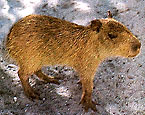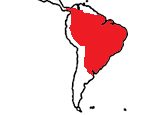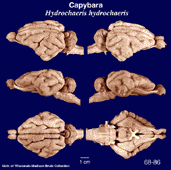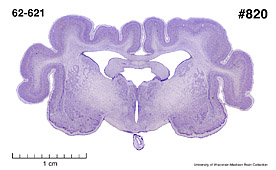|
Capybara
Hydrochaeris hydrochaeris
H. hydrochaeris is the single living species and genus
and is the largest living rodent. Head and body lengths of H.
hydrochaeris range from 100-130 cm and the tail is vestigial.
Shoulder height can reach up to 50 cm and weights average between
27 and 79 kg. The hair is very sparse and coarse. Coloration
is reddish brown to gray above and yellowish brown below. There
may be some black coloration on the face, outer surface of the
limbs and rump. Adult males have a large, bare patch on the
snout which contains an enlarged sebaceous gland. The head is
large and broad with relatively small, rounded ears. The eyes
a small and placed fairly far back on the head. The muzzle is
large with an enlarged upper lip. The front feet each have four
digits and the back feet have three each. Females have five
pairs of ventral mammae.
H. hydrochaeris inhabits densely vegetated areas around
ponds, lakes, rivers, streams, marshes, and swamps. There is
no permanent den, but rather the Capybara uses thickets for
shelter. Where undisturbed, Capybaras are active during the
morning and again in the evening, resting in shallow depressions
in the ground in the heat of the day. In areas where H. hydrochaeris
is disturbed by humans, activity is primarily nocturnal. It
runs similarly to a horse and, if pursued, will enter the water
swimming and diving with ease, the eyes and nostrils being the
only visible body parts.
The
diet consists mainly of grasses and is often seen grazing among
cattle, It also consumes aquatic plants, grains, melons, and
squashes.
Capybaras live in herds comprised of a breeding pair of animals
to several breeding pairs and their offspring. There is generally
a dominant male in the herd creating an aggressive hierarchy
which is continually challenged. Vocalizations include low,
clicking sounds indicating contentment; sharp whistles; abrupt
grunts; and weak barks.
Breeding seasons vary throughout the range. Mating occurs year
round in Venezuela, peaking around April and May just prior
to the beginning of the rainy season. In Argentina, October
is the preferred month, also just before the rainy season there.
Usually, one litter is produced each year, though if conditions
are favorable, there may be two. Gestation is between 149 -
156 days. Litter sizes range from 1-8 offspring, averaging 5
young. The babies weigh about 1,500 grams and the mother lactates
for about 16 weeks. The young are precocial, able to follow
their mother and eat grass soon after birth. Life span in the
wild is 8-10 years.
H. hydrochaeris is found in E Panama, E Venezuela, the Guyanas
and Peru, south through Brazil, Paraguay, NE Argentina, and
Uruguay.
|



